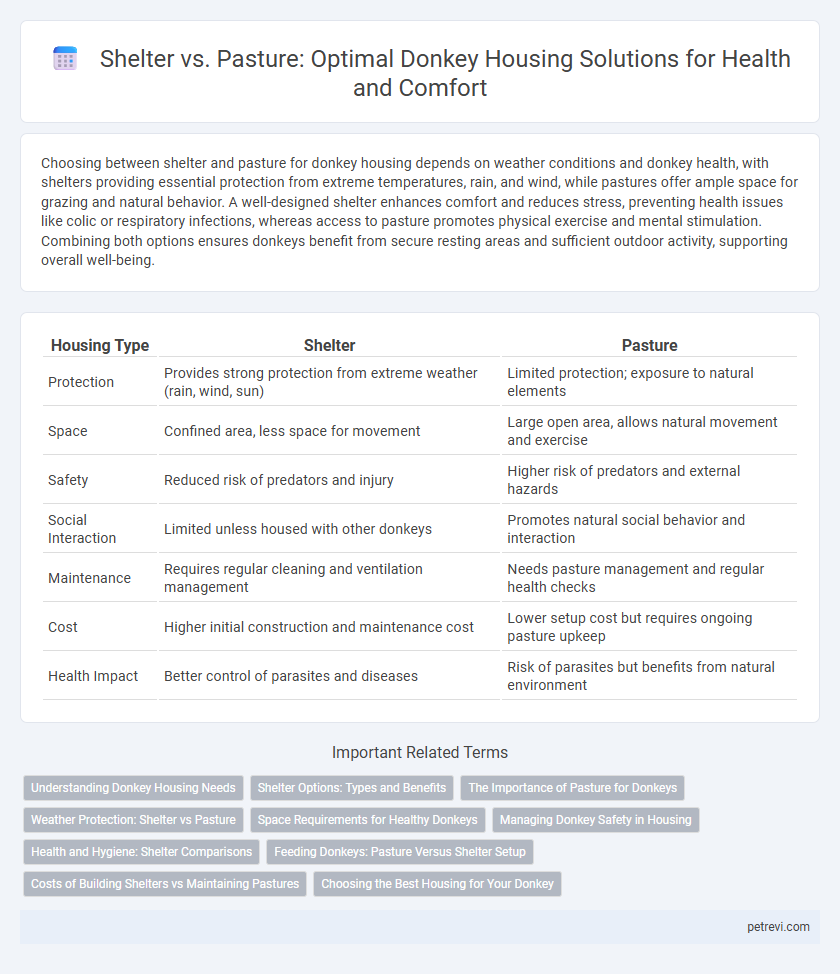Choosing between shelter and pasture for donkey housing depends on weather conditions and donkey health, with shelters providing essential protection from extreme temperatures, rain, and wind, while pastures offer ample space for grazing and natural behavior. A well-designed shelter enhances comfort and reduces stress, preventing health issues like colic or respiratory infections, whereas access to pasture promotes physical exercise and mental stimulation. Combining both options ensures donkeys benefit from secure resting areas and sufficient outdoor activity, supporting overall well-being.
Table of Comparison
| Housing Type | Shelter | Pasture |
|---|---|---|
| Protection | Provides strong protection from extreme weather (rain, wind, sun) | Limited protection; exposure to natural elements |
| Space | Confined area, less space for movement | Large open area, allows natural movement and exercise |
| Safety | Reduced risk of predators and injury | Higher risk of predators and external hazards |
| Social Interaction | Limited unless housed with other donkeys | Promotes natural social behavior and interaction |
| Maintenance | Requires regular cleaning and ventilation management | Needs pasture management and regular health checks |
| Cost | Higher initial construction and maintenance cost | Lower setup cost but requires ongoing pasture upkeep |
| Health Impact | Better control of parasites and diseases | Risk of parasites but benefits from natural environment |
Understanding Donkey Housing Needs
Donkeys require shelter that provides protection from extreme weather conditions such as intense sun, heavy rain, and cold wind to maintain their health and comfort. While pasture offers space for grazing and exercise, a well-constructed shelter with solid walls and a roof is essential to prevent stress and illnesses caused by exposure. Proper housing balances access to open pasture with secure, dry shelter, ensuring donkeys stay safe and thrive in various climates.
Shelter Options: Types and Benefits
Shelters for donkey housing include run-in sheds, three-sided shelters, and traditional barns that provide protection from extreme weather and predators. These structures enhance donkey welfare by offering shade, windbreak, and rain protection, which is essential for maintaining their health and preventing stress-related behaviors. Selecting shelter types with proper ventilation and dry flooring supports overall donkey comfort and reduces risks of respiratory infections and hoof problems.
The Importance of Pasture for Donkeys
Pasture provides donkeys with essential space for natural grazing behaviors and exercise, promoting their physical health and mental well-being. Access to pasture helps prevent obesity and hoof problems by enabling regular movement and diverse forage intake. Properly managed pasture also supports social interaction among donkeys, reducing stress and aggressive behaviors common in confined shelter environments.
Weather Protection: Shelter vs Pasture
Shelter provides donkeys with immediate protection from extreme weather conditions such as heavy rain, strong winds, and intense heat, reducing the risk of illness and heat stress. Pastures offer natural shade and ventilation but may not adequately shield donkeys from sudden weather changes or prolonged exposure to harsh elements. Optimal donkey welfare involves combining secure, weather-resistant shelters with spacious pastures to balance protection and natural environmental benefits.
Space Requirements for Healthy Donkeys
Donkeys require adequate space to ensure their physical health and psychological well-being, with shelters providing protection from harsh weather conditions while pastures offer ample room for exercise and social interaction. Optimal donkey housing involves a shelter size of at least 12 feet by 12 feet per donkey, complemented by a pasture area of at least one acre per animal to support natural grazing and movement. Maintaining sufficient space in both shelter and pasture reduces stress, prevents hoof problems, and promotes overall donkeys' durability and vitality.
Managing Donkey Safety in Housing
Proper donkey housing prioritizes safety through secure shelters that protect against extreme weather, predators, and injury risks common in open pastures. Enclosed shelters with sturdy construction and adequate ventilation minimize exposure to harsh elements and reduce stress-related behaviors. Regular maintenance and monitoring ensure that both shelter and pasture environments remain safe and comfortable for donkey well-being.
Health and Hygiene: Shelter Comparisons
Shelter housing for donkeys provides controlled environments that protect against extreme weather, reducing risks of respiratory infections and skin conditions commonly caused by dampness and cold. Clean, well-ventilated shelters minimize parasite infestations and promote better hygiene compared to pasture housing, which exposes donkeys to mud and feces accumulation. Properly designed shelters also facilitate regular cleaning and waste management, crucial for maintaining optimal health and preventing zoonotic diseases.
Feeding Donkeys: Pasture Versus Shelter Setup
Feeding donkeys in a pasture setup allows access to natural forage, promoting digestive health through continuous grazing on grasses and shrubs rich in fiber. Shelter housing requires provision of hay and formulated feeds to meet dietary needs, demanding careful storage and regular feeding schedules to prevent nutritional deficiencies. Both environments necessitate clean water availability, but pasture systems often reduce feed costs and mimic the donkey's natural diet more closely.
Costs of Building Shelters vs Maintaining Pastures
Building shelters for donkeys typically involves higher initial costs due to materials and construction, averaging $500 to $2,500 per unit depending on size and design complexity. Maintaining pastures demands ongoing expenses such as fencing repairs, rotational grazing management, and weed control, which can range from $200 to $600 annually per acre. Long-term shelter investment reduces weather-related health problems, potentially lowering veterinary costs, while pasture maintenance supports natural foraging but may increase feed supplementation expenses during adverse seasons.
Choosing the Best Housing for Your Donkey
Choosing the best housing for your donkey involves considering both shelter and pasture options to ensure comfort and health. A sturdy shelter provides essential protection from extreme weather conditions, including rain, wind, and excessive sun, which helps prevent respiratory issues and skin problems. Meanwhile, ample pasture space allows donkeys to graze naturally, promoting physical activity and mental stimulation, making a combination of secure shelter with access to pasture the ideal approach for optimal donkey welfare.
Shelter vs Pasture for Donkey Housing Infographic

 petrevi.com
petrevi.com